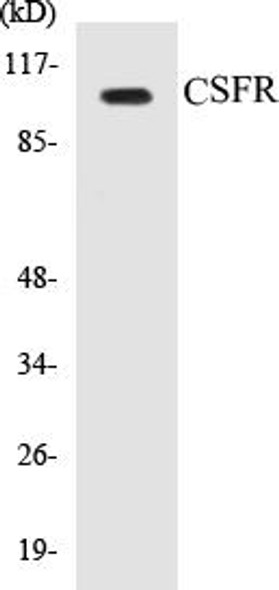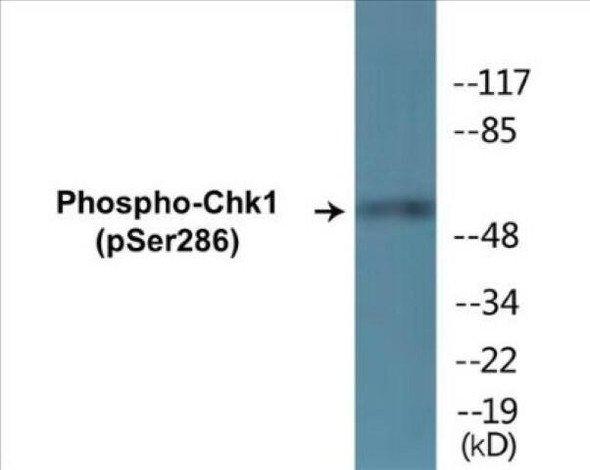CSFR (Phospho-Tyr723) Colorimetric Cell-Based ELISA Kit
- SKU:
- CBCAB00018
- Product Type:
- ELISA Kit
- ELISA Type:
- Cell Based Phospho Specific
- Research Area:
- Immunology
- Reactivity:
- Human
- Mouse
- Rat
- Detection Method:
- Colorimetric
Description
CSFR (Phospho-Tyr723)Colorimetric Cell-Based ELISA Kit
The CSFR Phospho-Tyr723 Colorimetric Cell-Based ELISA Kit is specifically designed for the accurate detection of phosphorylated CSFR (Colony-Stimulating Factor Receptor) at tyrosine 723 in cell lysates. This kit offers high sensitivity and specificity, allowing for precise measurement of CSFR activation levels in a variety of cell types.CSFR is a key receptor involved in cell signaling pathways that regulate cell growth, differentiation, and survival. Phosphorylation of CSFR at specific tyrosine residues is known to play a critical role in the activation of downstream signaling cascades, which can ultimately influence cellular processes such as proliferation and differentiation.By accurately measuring the phosphorylation status of CSFR at tyrosine 723, researchers can gain valuable insights into the activation of this receptor and its role in various cellular processes.
This information can be essential for studying signaling pathways, understanding disease mechanisms, and developing targeted therapies for conditions such as cancer, inflammation, and autoimmune diseases.Overall, the CSFR Phospho-Tyr723 Colorimetric Cell-Based ELISA Kit offers a reliable and efficient solution for studying CSFR activation in cell lysates, providing researchers with the tools they need to advance their understanding of cellular signaling pathways and potential therapeutic targets.
| Product Name: | CSFR (Phospho-Tyr723) Colorimetric Cell-Based ELISA |
| Product Code: | CBCAB00018 |
| ELISA Type: | Cell-Based |
| Target: | CSFR (Phospho-Tyr723) |
| Reactivity: | Human, Mouse, Rat |
| Dynamic Range: | > 5000 Cells |
| Detection Method: | Colorimetric 450 nm |
| Format: | 2 x 96-Well Microplates |
The CSFR (Phospho-Tyr723) Colorimetric Cell-Based ELISA Kit is a convenient, lysate-free, high throughput and sensitive assay kit that can detect CSFR protein phosphorylation and expression profile in cells. The kit can be used for measuring the relative amounts of phosphorylated CSFR in cultured cells as well as screening for the effects that various treatments, inhibitors (ie. siRNA or chemicals), or activators have on CSFR phosphorylation.
Qualitative determination of CSFR (Phospho-Tyr723) concentration is achieved by an indirect ELISA format. In essence, CSFR (Phospho-Tyr723) is captured by CSFR (Phospho-Tyr723)-specific primary antibodies while the HRP-conjugated secondary antibodies bind the Fc region of the primary antibody. Through this binding, the HRP enzyme conjugated to the secondary antibody can catalyze a colorimetric reaction upon substrate addition. Due to the qualitative nature of the Cell-Based ELISA, multiple normalization methods are needed:
| 1. | A monoclonal antibody specific for human GAPDH is included to serve as an internal positive control in normalizing the target absorbance values. |
| 2. | Following the colorimetric measurement of HRP activity via substrate addition, the Crystal Violet whole-cell staining method may be used to determine cell density. After staining, the results can be analysed by normalizing the absorbance values to cell amounts, by which the plating difference can be adjusted. |
| Database Information: | Gene ID: 1436, UniProt ID: P07333, OMIM: 164770, Unigene: Hs.586219/Hs.654394 |
| Gene Symbol: | CSF1R |
| Sub Type: | Phospho |
| UniProt Protein Function: | CSFR: an oncogenic tyrosine kinase receptor for CSF-1 (M-CSF). Drives growth and development of monocytes. Binding of CSF-1 induces receptor dimerization, activation and autophosphorylation of cytoplasmic tyrosine residues used as docking sites for SH2-containing signaling proteins. There are at least five major tyrosine autophosphorylation sites. Two point mutations seen in 10-20% of patients with acute myeloid leukemia, chronic myelomonocytic leukemia or myelodysplasia. One mutation appears to be both somatic and germline, and disrupts Cbl binding and receptor turnover. v-fms lacks the Cbl binding site and causes feline leukemia. Mutations may also develop after chemotherapy for lymphoma. A distinct point mutation was found in some cases of hepatocellular carcinoma and related to increased expression, and another mutation was found in 2 of 40 patients with idiopathic myelofibrosis. Expression is elevated in breast tumors and cell lines, and expression in xenografts and transgenic mice has been correlated with xenograft growth and breast cancer development. Inhibitors: Ki-20227 and other Kit/PDGFR inhibitors. |
| UniProt Protein Details: | Protein type:Kinase, protein; Membrane protein, integral; EC 2.7.10.1; Protein kinase, tyrosine (receptor); Oncoprotein; Protein kinase, TK; TK group; PDGFR family Chromosomal Location of Human Ortholog: 5q32 Cellular Component: cell surface; integral to plasma membrane; intracellular; plasma membrane Molecular Function:ATP binding; cytokine binding; macrophage colony stimulating factor receptor activity; protein homodimerization activity; protein phosphatase binding Biological Process: axon guidance; cell proliferation; cytokine and chemokine mediated signaling pathway; forebrain neuron differentiation; hemopoiesis; inflammatory response; innate immune response; intercellular junction maintenance; macrophage differentiation; monocyte differentiation; multicellular organismal development; negative regulation of apoptosis; negative regulation of cell proliferation; olfactory bulb development; osteoclast differentiation; peptidyl-tyrosine phosphorylation; phosphatidylinositol metabolic process; phosphoinositide-mediated signaling; positive regulation of cell migration; positive regulation of cell proliferation; positive regulation of osteoclast differentiation; positive regulation of protein amino acid phosphorylation; positive regulation of tyrosine phosphorylation of Stat3 protein; protein amino acid autophosphorylation; regulation of bone resorption; regulation of cell shape; ruffle organization and biogenesis; signal transduction; skeletal muscle development; transmembrane receptor protein tyrosine kinase signaling pathway Disease: Leukoencephalopathy, Diffuse Hereditary, With Spheroids |
| NCBI Summary: | The protein encoded by this gene is the receptor for colony stimulating factor 1, a cytokine which controls the production, differentiation, and function of macrophages. This receptor mediates most if not all of the biological effects of this cytokine. Ligand binding activates the receptor kinase through a process of oligomerization and transphosphorylation. The encoded protein is a tyrosine kinase transmembrane receptor and member of the CSF1/PDGF receptor family of tyrosine-protein kinases. Mutations in this gene have been associated with a predisposition to myeloid malignancy. The first intron of this gene contains a transcriptionally inactive ribosomal protein L7 processed pseudogene oriented in the opposite direction. Alternative splicing results in multiple transcript variants. [provided by RefSeq, Dec 2013] |
| UniProt Code: | P07333 |
| NCBI GenInfo Identifier: | 547770 |
| NCBI Gene ID: | 1436 |
| NCBI Accession: | P07333.2 |
| UniProt Secondary Accession: | P07333,Q6LDW5, Q6LDY4, Q86VW7, B5A955, D3DQG2, |
| UniProt Related Accession: | P07333 |
| Molecular Weight: | 33,248 Da |
| NCBI Full Name: | Macrophage colony-stimulating factor 1 receptor |
| NCBI Synonym Full Names: | colony stimulating factor 1 receptor |
| NCBI Official Symbol: | CSF1R |
| NCBI Official Synonym Symbols: | FMS; CSFR; FIM2; HDLS; C-FMS; CD115; CSF-1R; M-CSF-R |
| NCBI Protein Information: | macrophage colony-stimulating factor 1 receptor |
| UniProt Protein Name: | Macrophage colony-stimulating factor 1 receptor |
| UniProt Synonym Protein Names: | CSF-1 receptor (EC:2.7.10.1); CSF-1-R; CSF-1R; M-CSF-R; Proto-oncogene c-Fms; CD_antigen: CD115 |
| Protein Family: | Macrophage colony-stimulating factor 1 receptor |
| UniProt Gene Name: | CSF1R |
| UniProt Entry Name: | CSF1R_HUMAN |
| Component | Quantity |
| 96-Well Cell Culture Clear-Bottom Microplate | 2 plates |
| 10X TBS | 24 mL |
| Quenching Buffer | 24 mL |
| Blocking Buffer | 50 mL |
| 15X Wash Buffer | 50 mL |
| Primary Antibody Diluent | 12 mL |
| 100x Anti-Phospho Target Antibody | 60 µL |
| 100x Anti-Target Antibody | 60 µL |
| Anti-GAPDH Antibody | 60 µL |
| HRP-Conjugated Anti-Rabbit IgG Antibody | 12 mL |
| HRP-Conjugated Anti-Mouse IgG Antibody | 12 mL |
| SDS Solution | 12 mL |
| Stop Solution | 24 mL |
| Ready-to-Use Substrate | 12 mL |
| Crystal Violet Solution | 12 mL |
| Adhesive Plate Seals | 2 seals |
The following materials and/or equipment are NOT provided in this kit but are necessary to successfully conduct the experiment:
- Microplate reader able to measure absorbance at 450 nm and/or 595 nm for Crystal Violet Cell Staining (Optional)
- Micropipettes with capability of measuring volumes ranging from 1 µL to 1 ml
- 37% formaldehyde (Sigma Cat# F-8775) or formaldehyde from other sources
- Squirt bottle, manifold dispenser, multichannel pipette reservoir or automated microplate washer
- Graph paper or computer software capable of generating or displaying logarithmic functions
- Absorbent papers or vacuum aspirator
- Test tubes or microfuge tubes capable of storing ≥1 ml
- Poly-L-Lysine (Sigma Cat# P4832 for suspension cells)
- Orbital shaker (optional)
- Deionized or sterile water
*Note: Protocols are specific to each batch/lot. For the correct instructions please follow the protocol included in your kit.
| Step | Procedure |
| 1. | Seed 200 µL of 20,000 adherent cells in culture medium in each well of a 96-well plate. The plates included in the kit are sterile and treated for cell culture. For suspension cells and loosely attached cells, coat the plates with 100 µL of 10 µg/ml Poly-L-Lysine (not included) to each well of a 96-well plate for 30 minutes at 37°C prior to adding cells. |
| 2. | Incubate the cells for overnight at 37°C, 5% CO2. |
| 3. | Treat the cells as desired. |
| 4. | Remove the cell culture medium and rinse with 200 µL of 1x TBS, twice. |
| 5. | Fix the cells by incubating with 100 µL of Fixing Solution for 20 minutes at room temperature. The 4% formaldehyde is used for adherent cells and 8% formaldehyde is used for suspension cells and loosely attached cells. |
| 6. | Remove the Fixing Solution and wash the plate 3 times with 200 µL 1x Wash Buffer for five minutes each time with gentle shaking on the orbital shaker. The plate can be stored at 4°C for a week. |
| 7. | Add 100 µL of Quenching Buffer and incubate for 20 minutes at room temperature. |
| 8. | Wash the plate 3 times with 1x Wash Buffer for 5 minutes each time. |
| 9. | Add 200 µL of Blocking Buffer and incubate for 1 hour at room temperature. |
| 10. | Wash 3 times with 200 µL of 1x Wash Buffer for 5 minutes each time. |
| 11. | Add 50 µL of 1x primary antibodies Anti-CSFR (Phospho-Tyr723) Antibody, Anti-CSFR Antibody and/or Anti-GAPDH Antibody) to the corresponding wells, cover with Parafilm and incubate for 16 hours (overnight) at 4°C. If the target expression is known to be high, incubate for 2 hours at room temperature. |
| 12. | Wash 3 times with 200 µL of 1x Wash Buffer for 5 minutes each time. |
| 13. | Add 50 µL of 1x secondary antibodies (HRP-Conjugated AntiRabbit IgG Antibody or HRP-Conjugated Anti-Mouse IgG Antibody) to corresponding wells and incubate for 1.5 hours at room temperature. |
| 14. | Wash 3 times with 200 µL of 1x Wash Buffer for 5 minutes each time. |
| 15. | Add 50 µL of Ready-to-Use Substrate to each well and incubate for 30 minutes at room temperature in the dark. |
| 16. | Add 50 µL of Stop Solution to each well and read OD at 450 nm immediately using the microplate reader. |
(Additional Crystal Violet staining may be performed if desired – details of this may be found in the kit technical manual.)










